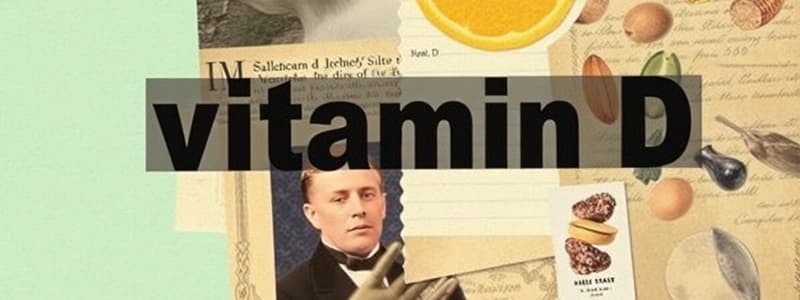Podcast
Questions and Answers
What is the primary consequence of Vitamin D deficiency in children?
What is the primary consequence of Vitamin D deficiency in children?
- Development of osteoporosis
- Failure of bones to grow properly (correct)
- Increased risk of fractures
- Delayed muscle coordination
What condition is commonly associated with the progressive loss of bone density in the elderly?
What condition is commonly associated with the progressive loss of bone density in the elderly?
- Rickets
- Hypervitaminosis D
- Osteoporosis (correct)
- Osteomalacia
Which of the following is a symptom associated with osteomalacia?
Which of the following is a symptom associated with osteomalacia?
- Widening of growth plates
- Bowed legs or knock-knees (correct)
- Delayed milestones
- Enlarged wrists
What is the upper limit of Vitamin D intake recommended to avoid toxicity?
What is the upper limit of Vitamin D intake recommended to avoid toxicity?
Which of the following conditions is NOT a result of Vitamin D deficiency?
Which of the following conditions is NOT a result of Vitamin D deficiency?
What are the two main forms of vitamin D found in dietary sources?
What are the two main forms of vitamin D found in dietary sources?
Which of the following countries reports a very high prevalence of vitamin D deficiency?
Which of the following countries reports a very high prevalence of vitamin D deficiency?
What is the recommended daily allowance of Vitamin D for adults?
What is the recommended daily allowance of Vitamin D for adults?
Which of the following is NOT a dietary source of Vitamin D?
Which of the following is NOT a dietary source of Vitamin D?
What role does Vitamin D play in the body?
What role does Vitamin D play in the body?
Which statement about vitamin D metabolism is correct?
Which statement about vitamin D metabolism is correct?
What is the consequence of chronic vitamin D deficiency?
What is the consequence of chronic vitamin D deficiency?
What is the primary function of the 1-hydroxylase enzyme in vitamin D metabolism?
What is the primary function of the 1-hydroxylase enzyme in vitamin D metabolism?
Which food has the highest amount of vitamin D per 100 grams?
Which food has the highest amount of vitamin D per 100 grams?
What is the chemical name of vitamin D2?
What is the chemical name of vitamin D2?
What is the inactive form of vitamin D that is created in the kidney?
What is the inactive form of vitamin D that is created in the kidney?
Which vitamin D form undergoes the first hydroxylation in the liver?
Which vitamin D form undergoes the first hydroxylation in the liver?
What is the primary storage form of vitamin D in the body?
What is the primary storage form of vitamin D in the body?
Which of the following statements about 7-dehydro-cholesterol is true?
Which of the following statements about 7-dehydro-cholesterol is true?
How long can vitamin D typically be stored in the liver?
How long can vitamin D typically be stored in the liver?
What is the active form of vitamin D called?
What is the active form of vitamin D called?
Which function is NOT directly associated with vitamin D?
Which function is NOT directly associated with vitamin D?
Which vitamin D status is classified as 'insufficiency' according to the US Endocrine Society classifications?
Which vitamin D status is classified as 'insufficiency' according to the US Endocrine Society classifications?
What is the result of calcitriol entering intestinal cells?
What is the result of calcitriol entering intestinal cells?
Which of the following effects of vitamin D is associated with its action on bones?
Which of the following effects of vitamin D is associated with its action on bones?
What is a potential result of calcium homeostasis regulated by vitamin D?
What is a potential result of calcium homeostasis regulated by vitamin D?
In the context of vitamin D metabolism, what does the term 'calcitriol' refer to?
In the context of vitamin D metabolism, what does the term 'calcitriol' refer to?
Which effect on the cardiovascular system is attributed to vitamin D?
Which effect on the cardiovascular system is attributed to vitamin D?
What is the effect of high doses of vitamin D on bone health?
What is the effect of high doses of vitamin D on bone health?
Which of the following statements about Vitamin D and immune function is true?
Which of the following statements about Vitamin D and immune function is true?
Which of the following substances is primarily released due to the action of calcitriol in the intestines?
Which of the following substances is primarily released due to the action of calcitriol in the intestines?
What is the primary effect of calcitriol on the kidney regarding calcium levels?
What is the primary effect of calcitriol on the kidney regarding calcium levels?
What serum calcium level indicates hypocalcemia?
What serum calcium level indicates hypocalcemia?
Which hormone acts as the principal acute regulator of blood calcium levels?
Which hormone acts as the principal acute regulator of blood calcium levels?
Which of the following is NOT a cause of vitamin D deficiency?
Which of the following is NOT a cause of vitamin D deficiency?
What effect does 1,25-(OH)₂D₃ have on the gastrointestinal tract?
What effect does 1,25-(OH)₂D₃ have on the gastrointestinal tract?
Which of the following is a feature of rickets?
Which of the following is a feature of rickets?
What happens to PTH levels when serum calcium decreases?
What happens to PTH levels when serum calcium decreases?
What is craniotabes?
What is craniotabes?
What is the role of 1,25-(OH)₂D₃ in relation to PTH synthesis?
What is the role of 1,25-(OH)₂D₃ in relation to PTH synthesis?
Which condition is characterized by beaded ribs?
Which condition is characterized by beaded ribs?
Flashcards
Vitamin D forms
Vitamin D forms
Vitamin D exists in two forms: D2 (Ergocalciferol) and D3 (Cholecalciferol). D3 is the natural form for animals and humans.
Vitamin D source (diet)
Vitamin D source (diet)
Dietary sources include sunlight, fatty fish (salmon, tuna), egg yolks, and fortified foods. Mushrooms also contain Vitamin D2.
Vitamin D function
Vitamin D function
Vitamin D acts like a hormone, regulating calcium levels and bone health.
Vitamin D - Cholesterol relation
Vitamin D - Cholesterol relation
Signup and view all the flashcards
Vitamin D in humans
Vitamin D in humans
Signup and view all the flashcards
Vitamin D deficiency prevalence
Vitamin D deficiency prevalence
Signup and view all the flashcards
Vitamin D's chemical form
Vitamin D's chemical form
Signup and view all the flashcards
Vitamin D3 Source
Vitamin D3 Source
Signup and view all the flashcards
Vitamin D2 Source
Vitamin D2 Source
Signup and view all the flashcards
Active Vitamin D
Active Vitamin D
Signup and view all the flashcards
Vitamin D Storage
Vitamin D Storage
Signup and view all the flashcards
Vitamin D activation site
Vitamin D activation site
Signup and view all the flashcards
7-dehydrocholesterol
7-dehydrocholesterol
Signup and view all the flashcards
25-hydroxy vitamin D3
25-hydroxy vitamin D3
Signup and view all the flashcards
Calcitriol
Calcitriol
Signup and view all the flashcards
Food Vitamin D sources
Food Vitamin D sources
Signup and view all the flashcards
Harrison Groove
Harrison Groove
Signup and view all the flashcards
Rickets
Rickets
Signup and view all the flashcards
Osteomalacia
Osteomalacia
Signup and view all the flashcards
Osteoporosis
Osteoporosis
Signup and view all the flashcards
Vitamin D Toxicity
Vitamin D Toxicity
Signup and view all the flashcards
What does Vitamin D do for calcium?
What does Vitamin D do for calcium?
Signup and view all the flashcards
Calcitriol's role in bone health
Calcitriol's role in bone health
Signup and view all the flashcards
Vitamin D deficiency
Vitamin D deficiency
Signup and view all the flashcards
Vitamin D sufficiency
Vitamin D sufficiency
Signup and view all the flashcards
Vitamin D - Liver
Vitamin D - Liver
Signup and view all the flashcards
Vitamin D - Kidney
Vitamin D - Kidney
Signup and view all the flashcards
Calcitriol's many roles
Calcitriol's many roles
Signup and view all the flashcards
Vitamin D and immune system
Vitamin D and immune system
Signup and view all the flashcards
Vitamin D and cellular processes
Vitamin D and cellular processes
Signup and view all the flashcards
Vitamin D and other organs
Vitamin D and other organs
Signup and view all the flashcards
Calcitriol's Action on Kidneys
Calcitriol's Action on Kidneys
Signup and view all the flashcards
Hypocalcemia
Hypocalcemia
Signup and view all the flashcards
Parathyroid Hormone (PTH) - Role
Parathyroid Hormone (PTH) - Role
Signup and view all the flashcards
Calcitriol's Actions
Calcitriol's Actions
Signup and view all the flashcards
Maintaining Blood Calcium Levels
Maintaining Blood Calcium Levels
Signup and view all the flashcards
Vitamin D Deficiency: Causes
Vitamin D Deficiency: Causes
Signup and view all the flashcards
Rickets: Features
Rickets: Features
Signup and view all the flashcards
Craniotabes
Craniotabes
Signup and view all the flashcards
Frontal Bossing
Frontal Bossing
Signup and view all the flashcards
Beaded Ribs
Beaded Ribs
Signup and view all the flashcards
Study Notes
Vitamin D Overview
- Vitamin D is a fat-soluble vitamin; a sterol containing a cyclopentanoperhydrophenanthrene ring
- Vitamin D functions like a hormone
- Two forms: Vitamin D2 (Ergocalciferol) and Vitamin D3 (Cholecalciferol) which is the natural form in animals/man, created in bodies from cholesterol and 7-dehydrocholesterol
- An alternative form of Vitamin D2 is commercially prepared from ergosterol found in yeast
- Vitamin D's molecular structure closely resembles that of classic steroid hormones
Vitamin D Dietary Sources
- Sunlight
- Cod liver oil
- Caviar
- Mackeral
- Salmon
- Sardines
- Cheese (in some)
- Raw milk
- Mushrooms
- Tuna
- Eggs
- Oysters
- Cerals (fortified)
- Butter (in some)
- Processed cheese (fortified)
- Almond milk
- Soy milk
Vitamin D- RDA
- 200-400 IU/day [5-10µg/day]
- 1 microgram of vitamin D = 40 International Units
Vitamin D Deficiency Most Common
- Worldwide, many countries report a high prevalence of low vitamin D status (25(OH)D levels < 30 nmol/L or 1 ng/ml) in >20% of the population.
- Common in India, Tunisia, Pakistan, and Afghanistan
Formation of Vitamin D
- Skin (UV light): 7-dehydrocholesterol → vitamin D3
- Liver: OH-group added (first hydroxylation). Storage form of vitamin D (3 months storage in liver)
- Kidney: OH-group added by 1-hydroxylase (second hydroxylation). 1,25-dihydroxyvitamin D3 (or 1,25-dihydroxy cholecalciferol, 1,25-DHCC) - active form of vitamin D, a steroid hormone; 24,25-dihydroxy -vitamin D - an inactive form, ready for excretion
Calcitriol Synthesis
- UV light → 7-dehydrocholesterol → Previtamin D → Cholecalciferol (calciol)
- Liver → 25-OH-cholecalciferol (calcidiol)
- 24,25-(OH)2-cholecalciferol (inactive form)
- Kidney → Calcitriol (1,25-(OH)2-cholecalciferol - active form)
Vitamin D Transport
- Vitamin D is transported from the intestine to the liver by binding to vitamin D-binding globulin.
- 25-hydroxy D3 and 1,25-dihydroxy D3 are also transported in the blood by binding to vitamin D-binding globulin
- 25-hydroxycholecalciferol is the major storage and circulatory form of vitamin D.
Vitamin D Functions
- Calcium and Phosphorus Homeostasis: Absorption in small intestine, resorption (bone and kidney), maintains blood calcium levels
- Bone formation: Stimulates Calcium uptake for deposition.
- Regulation of gene expression; Cell growth
- Regulation of immune function; Growth and bone mineralization; Control of cell proliferation, etc
Vitamin D Promotes Intestinal Calcium Absorption
- Calcitriol enters the intestinal cell and binds to vitamin D receptor
- The hormone-receptor complex causes the release of Calbindin
- Increased availability of calcium-binding protein, increasing calcium absorption
Vitamin D Status in Relation to 25(OH)D Levels
- A range of serum calcium levels (8.5-10.5 mg/dl) classified as Normal.
- Deficiency below 20 ng/mL (50 nmol/L)
- Insufficiency (21–29 ng/mL (52.5–72.5) nmol/liter)
- Sufficient (>30 ng/mL)
- Risk of toxicity (>50 ng/mL or >150 ng/mL)
Vitamin D Deficiency: Causes
- Inadequate supply; Impaired absorption; Impaired production of 25-hydroxyvitamin D3; Impaired production of 1,25-dihydroxyvitamin D3; Resistant to the effects of 1,25-dihydroxyvitamin D3
Rickets
- Delayed milestones; Delayed closure of anterior fontanelle; Delayed dentition; Deformities of bones; Decreased serum calcium; Enlarged wrists and ankles; Growth plate widening
Osteomalacia
- Adult form of rickets.
- Adult form showing porous bones
Vitamin D Toxicity
- Hypervitaminosis D—Among the vitamins, vitamin D is the most toxic in overdoses
- Calcification of soft tissue
- hardening of arteries/stone formation in kidney
- Does not occur from sunlight or dietary sources, only from supplementations
Parathyroid Hormone (PTH)
- Principal acute regulator of blood [Ca2+]; hypercalcemic hormone in hypocalcemia.
Actions of Calcitriol on Intestine, Bone, and Kidney
- Increased Intestinal Absorption of Calcium/Phosphate
- Bone Mineralization at Low Doses, Calcium Mobilization From Bones at High Doses
- Increased Reabsorption of Calcium/Phosphorous in Kidneys, Decreasing Excretion
Studying That Suits You
Use AI to generate personalized quizzes and flashcards to suit your learning preferences.




